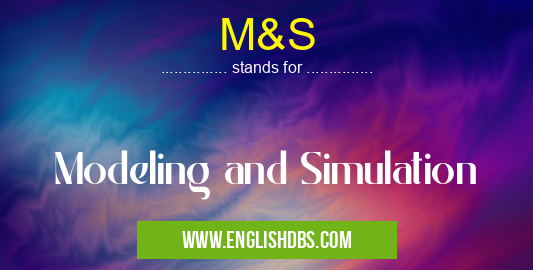What does M&S mean in MILITARY
M&S stands for Modeling and Simulation, a design and analysis technique used to explain the behavior of systems. This approach is especially useful in Governmental organizations, where simulation can be used to evaluate various policies or strategies before the implementation phase begins. The main purpose of using this technique is to create a virtual environment which can be used to examine different causes and effects scenarios. By using M&S, governmental officials and policy makers are able to gain reliable insights into how certain actions may play out over time or what kinds of outcomes may result from a different course of action.

M&S meaning in Military in Governmental
M&S mostly used in an acronym Military in Category Governmental that means Modeling and Simulation
Shorthand: M&S,
Full Form: Modeling and Simulation
For more information of "Modeling and Simulation", see the section below.
» Governmental » Military
Essential Questions and Answers on Modeling and Simulation in "GOVERNMENTAL»MILITARY"
What is Modeling and Simulation?
Modeling and Simulation is a technique used to analyze, understand, and predict the behavior of complex systems by representing them in digital form. It is often used in engineering, science, technology, healthcare, business and military applications.
What are the benefits of Modeling and Simulation?
Modeling and Simulation allows us to test various scenarios without risking any real-world costs or resources. It can help us optimize processes without trial and error experimentation. It also makes it possible to rapidly analyze data to find correlations quickly and accurately.
What types of problems can be solved using Modeling and Simulation?
Modeling and Simulation can be used to solve a variety of problems including optimization of infrastructure designs, simulation of dynamic system behaviors for risk mitigation, predictive modeling of behavioral patterns, forecasting population dynamics, finding optimal solutions in complex decision-making environments, developing new products or services through virtual prototyping, etc.
How will Modeling and Simulation help my business?
Using Modeling and Simulation in your business can help you identify cost efficiencies before investing large amounts of capital or resources as well as test out different scenarios for potential outcomes before making decisions. Also understanding system dynamics can uncover new opportunities for growth that may have been overlooked before.
Are there different types of simulations?
Yes, there are different types of simulations that perform different tasks such as agent-based simulation which simulates the activities between individuals in a system; discrete event simulation which models the behavior over time; Monte Carlo simulation which simulates many random events simultaneously; system dynamics simulation which uses feedback loops to analyse interactions between entities in a system; etc.
How does one create a good simulation?
To create a good simulation it is important to have an accurate model with valid assumptions about the behavior or interactions between entities being simulated. It also requires having the right data available with sufficient detail while understanding how reliable it is. Additionally collecting insights from people with experience in related domains helps fill gaps not embodied by available data sources.
What are some best practices for effective modeling & simulation?
Some best practices when using modeling & simulation include ensuring that all stakeholders are aligned on goals & objectives prior to beginning any model development; validating assumptions against actual data from available sources; testing & verifying results multiple times against realistic scenarios; communicating results clearly across teams so everyone understands what has been found; reconciling any discrepancies between expectations & reality & refining models accordingly.
What technologies are traditionally used for modeling & simulation?
Traditional technologies used for modeling & simulation include software such as MATLAB or R Studio which allow users to create mathematical models based on equations & machine learning algorithms; systems dynamics models built using Vensim or STELLA/iThink software platforms; agent-based simulations developed using AnyLogic or Repast Simphony toolsets; as well visual programming tools like Unity 3D or Unreal Engine 4.
Final Words:
In conclusion, M&S has become an invaluable tool in Governmental organizations across the world due to its ability to simulate environments and analyze data quickly and accurately enabling those at higher positions within bureaucratic structures make safer decisions with fewer risks involved. Government workers everywhere owe it all thanks to technology advancements like Modeling & Simulation which help us better understand our surroundings while simultaneously giving us higher confidence levels when making critical political choices.
